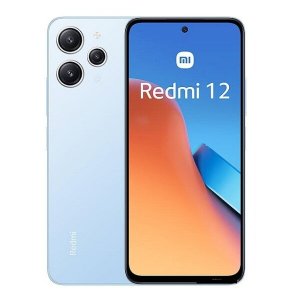Hot Models:
Samsung Galaxy Note 4
:
Apple iPhone 6
:
Samsung Galaxy Note Edge
:
Samsung Gear S
:
Motorola Moto G
:
Samsung Galaxy S5
10 Sep 2023

The newest model in Xiaomi's low-cost Redmi line is the Redmi 12 5G. Not to be confused with the Redmi 12, which is slightly different despite its unclear name. In addition to 5G, the Redmi 12 5G is a tier higher and has many additional features.
Both Redmi 12 smartphones are comparable in most respects. The 6.79-inch 90Hz display on both is the largest available on a Redmi phone from the main line. Both have an upgraded glass back and almost the same design. Both phones come equipped with a 50MP primary camera and a sizable 5000mAh battery.
The Redmi 12 5G has a Snapdragon 4 Gen 2 chip, while the Redmi 12 4G has a MediaTek Helio G88 chip. The Snapdragon 4 Gen 2 chip enables 5G connectivity, which is why the Redmi 12 5G is called that. Strangely, in any case, the standard Redmi 12 has a ultrawide camera notwithstanding the 50MP primary, something the more costly Redmi 12 5G needs.
UnBoxing Xiaomi Redmi 12:
A 22.5W charger and a charging cable with a USB-A connector are included with the Redmi 12 5G. Also included in the packing is a transparent, soft silicone case.

Design & Display of Xiaomi Redmi 12:
The Redmi 12 5G offers a stylish, classy appearance that belies its affordable price. The 6.79-inch display, the largest on a Redmi series device, dominates the front. Large bezels surround the display, but they don't detract too much from it. However, every time you swipe from the edge, the raised lining around the edges grazes against your thumb.
The phone's frame is made of plastic with a matte paint that almost looks like aluminum. The right side has the power button and the volume rocker. The power button has a unique mark sensor worked in, which functions admirably in spite of the restricted land accessible. There is a USB-C connector and a single loudspeaker and microphone on the phone's bottom. A headphone jack and an IR blaster can be found on the phone's top. The SIM tray is on the left side.
The phone's back is made of glass, giving it a more upscale appearance and a mirror-like reflection free from the warping associated with plastic. Additionally, it ought to be more resistant to scratches than glossy plastic, which is incredibly soft. The phone is available in the three hues seen here: pure glossy black, iridescent silver, and pastel blue.
The top camera lenses are placed in a manner that is now well-known, but there is no border around them, giving them a very sleek and contemporary appearance. It's a great touch that the lenses are embellished with metallic rings. The Redmi 12 5G has a 6.79-inch IPS LCD panel with a resolution of 2460 x 1080. The presentation yields in 8-cycle tone and can revive up to 90Hz.

The display does not have a very wide color gamut, so even when it is set to its default Vivid mode or the optional Saturated mode, the colors are not nearly as vibrant as they are when it is set to Standard or sRGB mode. The Standard mode has a superior aligned white point though the Striking and Standard are excessively cool and blue. Differentiation and dark level execution is good for an IPS board.
The Redmi 12 5G has a 6.79-inch IPS LCD panel with a resolution of 2460 x 1080. The presentation yields in 8-cycle tone and can revive up to 90Hz. The display does not have a very wide color gamut, so even when it is set to its default Vivid mode or the optional Saturated mode, the colors are not nearly as vibrant as they are when it is set to Standard or sRGB mode. The Standard mode has a superior aligned white point though the Striking and Standard are excessively cool and blue.

Differentiation and dark level execution is good for an IPS board. Seeing points aren't perfect as despite the fact that the tones don't move a lot, the board diminishes impressively when seen off-pivot.
Even in Default mode, the screen will most of the time refresh at 90 Hz, but when you stop interacting with it, it will only refresh at 48 Hz. While playing video, the presentation drops down to 30Hz for all satisfied underneath 30fps and 60Hz for content over that. We never saw it invigorating at 48Hz for 24fps or 48fps content. The LCD board has good movement execution so there aren't long diverting paths behind moving articles on screen.

The main remarkable weakness of the Redmi 12 5G presentation is the pinnacle splendor. The promoted 550 nits doesn't feel adequate when outside under direct daylight and things can get more diligently to see on occasion. By and large, nonetheless, the showcase on the Redmi 12 5G is entirely workable and, surprisingly, really great for a telephone in this cost range.
Speaker of Xiaomi Redmi 12:
There is only one down-firing loudspeaker on the Redmi 12 5G. When viewing content in landscape format, the sound is obviously incorrect, but when viewing the growing amount of portrait videos, it is not distracting.
The speaker is of subpar quality. The speaker sounds stuffy and crowded at low volumes, and volume boosts easily drown it out. At maximum level, all the sounds blend together and appear to be playing simultaneously. Additionally, the speaker doesn't become especially loud. We advise utilizing headphones whenever feasible as a result.
Camera of Xiaomi Redmi 12:
A 50MP f1.8 main camera and a 2MP depth sensor make up the Redmi 12 5G's dual camera system on the back. A single 8MP f2.0 fixed focus camera is located on the front.
The camera app is fairly easy to use. The various modes are organized at the base and can be swiped through. Likewise at the base is a zoom button yet rather than offering simple zoom flips it opens up a wheel that you then, at that point, need to physically slide through. Additional choices are at the top, and you don't have to stretch your thumb to get to them; The menu can be accessed by simply swiping down from anywhere on the viewfinder.

The phone's cameras aren't telephoto, and the digital zoom isn't excellent, but results up to a factor of two are still pretty useful. Unfortunately, there isn't much you can do to change the absence of an ultrawide camera. The 50MP setting merely upscales the 12MP photographs and doesn't offer any more fine detail.
Since there is no stabilization even at 1080p 30 fps, the highest supported recording resolution and frame rate, the footage captured while moving is frequently unusable unless you have a gimbal or are able to float.

Providing cell phone price review in Dubai - United Arab Emirates.
iPhone, Samsung Galaxy, HTC, Nokia, Windows phone price in Dubai with mobile phone review and specification.
Privacy Policy | Terms | Contact US
© 2025 fonfe.com All rights reserved.
iPhone, Samsung Galaxy, HTC, Nokia, Windows phone price in Dubai with mobile phone review and specification.
Privacy Policy | Terms | Contact US
© 2025 fonfe.com All rights reserved.









